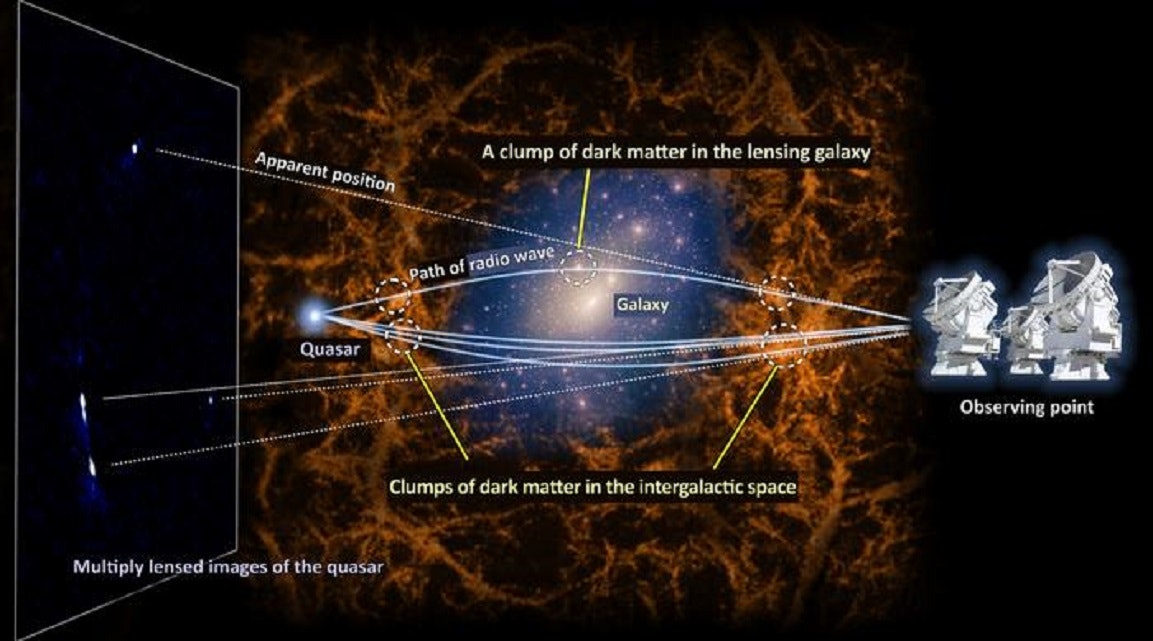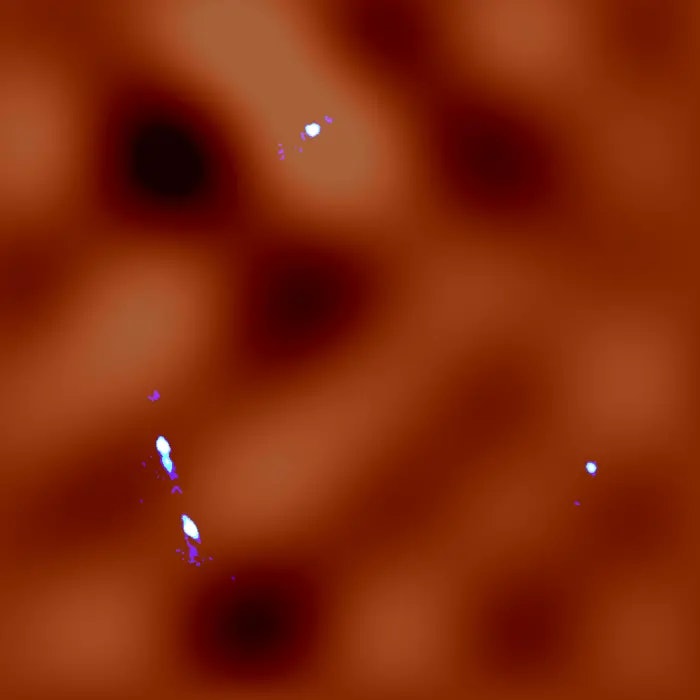
A distant galaxy may shed some light on dark matter.
A team of astronomers recently used the light of a distant galaxy to map the distribution of dark matter along a thin slice of space, which may bring us a step closer to understanding what this mysterious, unseen matter is — or at least what it isn’t.
Kindai University cosmologist Kaiki Taro Inoue and his colleagues published their work in The Astrophysical Journal.
Shedding Light on Dark Matter
Inoue and his colleagues used ALMA to observe how light from a distant galaxy bends as it passes through the powerful gravitational field of a nearby massive galaxy. Astronomers often use gravitational lensing to see distant, faint objects, because the curved fabric of space-time around massive objects acts as a cosmic magnifying glass. But Inoue and his colleagues were looking for stuff that couldn’t be seen under any magnification: dark matter.
The distant quasar — a galaxy with an actively-feeding supermassive black hole — happens to lie on the far side of a line running from Earth through a galaxy cluster called MG J0414+0534. As the quasar’s light passes through MG J0414, it gets magnified, warped, and split into four images, all at different angles.
By carefully examining and comparing the four images of the quasar, Inoue and his colleagues could figure out the shape of the curves in spacetime the light had followed to reach their telescope. Next, the team subtracted the effect of all the mass they could see in MG J0414, and all the dark matter that galaxy cluster should contain. What was left was basically a map of all the dark matter in a straight line between Earth and the distant quasar, at a resolution of about 30,000 light years.

Cosmic Cold Case
Dark matter makes up about 27 percent of the mass of our universe (another 68 percent is dark energy, and the other 5 percent is the stuff we can actually see and interact with), but physicists still don’t know what dark matter actually is. As the name suggests, dark matter doesn’t doesn’t shine or reflect light, and it also doesn’t absorb light. And the only way dark matter interacts with regular matter is through its gravity, which seems to play an important role in shaping the structures we see in the universe, from dwarf galaxies to superclusters. It’s one of the biggest mysteries in modern cosmology (the study of how our universe formed and how it’s evolving).
One idea is that dark matter is made of particles that zip through space at nearly the speed of light. If this theory, called “hot dark matter,” is correct, then neutrinos could be a form of dark matter. That would make some sense, because neutrinos don’t interact with light, and they interact with other matter only through gravity and what’s called the weak nuclear force.
Another theory, called “cold dark matter,” suggests that dark matter could be made of much slower-moving particles. If that’s the case, then dark matter could actually be swarms of tiny black holes that formed during the first second after the Big Bang; some could be less than a thousandth of a percent the mass of a paperclip, while others could have the mass of hundreds of thousands of stars. Cold dark matter might also be made of a whole new kind of elementary particle called an axion, or what’s called a weakly interacting massive particle.
At the moment, most cosmologists lean toward cold dark matter, because it seems to explain the structure of the universe better than hot dark matter. If dark matter is cold, then small objects should grow, merge together, and form larger objects and structures; dwarf galaxies, for example, should collide and form larger galaxies, which in turn form galaxy clusters, and so on. And that’s mostly what we see happening in the actual universe.
But there are still some important ways in which what we actually see in the universe doesn’t match what the theory predicts, especially at small scales. On a scale bigger than about 3.25 million light years, cold dark matter seems like the best fit. But if you zoom in to smaller distances, the problems start to appear. That may mean that dark matter is neither hot nor cold, but somewhere in the middle: warm dark matter, in other words.
Inoue and his colleagues measured the distribution of dark matter at a scale of about 30,000 light years, and they say their findings support the theory that dark matter is cold.

We’re Getting Warmer
"I think some warm dark matter models are ruled out by our result, but we need more careful analysis," Inoue tells Inverse. "If we can constrain the warm dark matter models with good accuracy then we can say that dark matter is not warm, and thus it should be cold."
To be sure, physicists need to be able to measure smaller clumps of dark matter than they currently can. The smallest clumps of dark matter we can detect at the moment are about 100 million times more massive than our Sun. But the precise data scientists like Inoue need to unravel the structure, and thus the nature, of dark matter will require measuring even smaller clumps, between 100,000 and a million times the mass of our Sun.
Meanwhile, Inoue and his colleagues are in the process of analyzing more gravitationally-lensed quasars and mapping dark matter in more thin slices of the sky.







